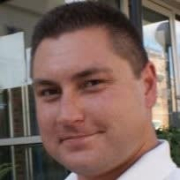What is our primary use case?
We are using it for monitoring and troubleshooting. It is cloud-based, but the collectors always have to be on-premise. We must be using its latest version.
How has it helped my organization?
It automatically updates your network topology, which has made any kind of troubleshooting or planning way more efficient. To make sure that everything is up for you, every 15 seconds, it checks for a device to be online and any network element to be up or down, and every minute, it checks for your other devices, such as your PCs or IP phones. It does a subnet scan every 600 seconds to see if thresholds are being pegged or have fallen off in certain levels. If you don't want to have so much ping traffic on your network, you can change that to whatever value you want. All that is customizable. It kind of becomes something you depend on when you're looking for a device. If I want to find out where a device is plugged in specifically, Auvik is the first place where I would go to check if I can see it there. Earlier, if I'm looking to see where a device is, I used to check my windows DHCP server and look for an odd or new IP address that had appeared. In Auvik, I can filter the map based on a device, subnet, or VLAN, or I can see all devices that are plugged into a specific switch, which is really convenient.
It has significantly decreased our mean time to resolution. In the past, sometimes, it took us a long time to come to the conclusion that this is the problem. When trying to go through the troubleshooting steps to know what the problem is, when Auvik has that information for me, troubleshooting is significantly quicker. I don't have to go through an entire department and look at their connections to see how they're impacted and then decide that everything they have in common is this switch. Auvik is able to tell me that this switch isn't online anymore. I can then say that we have a problem with a switch, and we're working on it to kind of calm folks down.
TrafficInsights dashboard is one of the first things that I log into every day in Auvik. Before going with Auvik, I tried a different solution for it, and that solution was just terrible in comparison. It only permitted five interfaces for traffic insights, and if you wanted more than five interfaces, it costed more money. It was just completely unreasonable. Auvik doesn't limit you on the number of interfaces for traffic insights. I get a better idea of the type of traffic on the network through Auvik than anywhere else. I can look at the type of traffic through my firewall monitoring, but I'd have to go a lot deeper into the protocols and ports that are being used just to see what's going on in the network.
With Auvik, if I look at traffic insights, I can get a good graph of how much traffic is happening at specific times a day. I can lay out the type of traffic and break it down based on the applications. I can then filter from there. If I'm seeing that we have a lot more web traffic or media streaming traffic, I can look a little bit deeper and see the exact applications, such as Netflix, YouTube, and TikTok. I can then see who is watching Netflix. It makes it a whole lot quicker than watching my firewall because I'd have to filter by a domain or IP address to come to the conclusion that someone is watching Netflix on the network. In Auvik, based on the filter, I can get all devices involved with that conversation to Netflix, which is a really nice feature. The other menus within TrafficInsights allow you to keep it all relative, so you're not resetting or recreating those filters. I can just filter based on Netflix and see who are the top users. I can see who is using Netflix and on which laptop they are using it.
The TrafficInsights feature helps in improving our overall network performance. It allows for me to look at a month's worth of time, and then I get an idea of what's the normal baseline. It helps me in getting a good baseline for expected backups because I can see when the backups are happening and how much traffic is related to backups. So, I can see when things are normal or abnormal. For example, when media streams are a little high, that's abnormal, so I will look into it a little bit deeper. It helps with this kind of stuff, and if there is any kind of impact on overall throughput for other users, I get to nip it in the bud right away, which is valuable.
The out-of-the-box device configuration backups save time and money too. With Auvik, I can see the configurations even if I have them saved on the file server or something like that. If I got a protected share that has configuration backups, being able to deploy that configuration or even save that configuration as a text file from Auvik is a time-saver. I am not paying for the other product any longer just because Auvik handles that. Previously, I would have been paying for both. If Auvik couldn't do that, I'd have to pay for two products, so it saves money, but more importantly, it saves time. I don't have to spend so much time going switch by switch.
What is most valuable?
The best feature is the support access. Access to Auvik support is right there within Auvik. It has a little support button at the bottom, you push it, and you get connected with a support agent. They can see your internet. They help you out, work with you, and answer your questions right there. I don't have to go and open up a ticket somewhere else and try to explain anything, which is a great feature. I can get someone in less than a minute, which is really helpful.
It is very simple. It is very easy to learn how to navigate, and their knowledge base is a good resource.
It is an SNMP-based platform. It can communicate with almost any device that you're trying to monitor, such as a switch or a router, through SNMP. If you're trying to monitor Windows machines, it uses WMI. It gives you a good layout of the sensors for a lot of devices. It can generate alerts based on if the fans are working, CPU is hot or highly utilized, or RAM is highly utilized.
The Syslog feature is also really valuable. I don't have to go into each individual box, so I have it all centralized. Everything is in one pane of glass. When I first started using Auvik, they didn't have the Syslog fully deployed. It was a beta. Now, it is fully deployed, and it is a great feature. Auvik really relies on SNMP in order to give you good information about a device, but our IP phones, for instance, don't support SNMP. With a phone pointed towards Auvik for the Syslog info, I can see the stats within Auvik, whereas before, I would have to go into the phone server and the phone to get an idea of what's happening with that phone. So, if someone is telling me that his phone keeps restarting or has bad call quality, I can go to that phone's Syslog within Auvik because even the phone itself doesn't store that information. Our phones only show the last six reasons for a reboot, and if someone is saying that reboot is the issue, then that's not good enough. You want to look for a pattern. You want to look for what might be happening internally on the phone. For that, you would have to go into the phone server and then get down to those logs. If the log info is already sent to Auvik, I don't have to go into the phone server and then write up a command to filter it down to just this little tiny query here. I could just look at that device, access the log info, and get what I need, which is very valuable.
It also gives you a live or close-to-live topology map. So, you can get down to things. For example, if all of a sudden a machine is really slow during the day for someone, or they lose connectivity, you can check out the machine baseline by name or by IP. When it is on a switch, you can check the port it is on and get the logs on that switch to see if there are any errors being generated on that port. So, it is just a lot quicker than going into the switch's interface. You can get information on the device via Auvik without going into each device separately. You can get a log, but you can't do any configuration changes. You can just get information on the devices, and then if you see that you need to make a configuration change. If you want, you can also tunnel in through that or do it externally. The ability to launch a console session to your switch, router, or any device that you're monitoring (if that device supports it), or launch a browser session through Auvik to that device is a nice little feature they have. You can interface right there through that single pane of glass.
It backs up my configurations for me. For the routers, I have a cloud-based subscription, and it backs up my configurations every 30 days. So, I can see the changes that were made, and then I can do an A/B comparison of the configurations and identify exactly what was changed. I can even redeploy the configurations from within Auvik, which is pretty handy.
I liked the Teams integration that exists in Auvik. We have Office 365, and I can create a channel within Teams where my alerts from Auvik pop up in Teams so that I can see a feed of different alerts. I have a feed of different levels of alerts such as emergency, critical, warning, and informational that are generated in Auvik, and if I'm not viewing the tab in my browser that has Auvik, and they pop up as alerts in Teams on my desktop. I might have a ton of tabs open, and if I am not viewing the tab that has Auvik, these alerts will pop up in Teams, and that'll get my attention. It also has the ability to send a text alert. It is indirect, and even though it comes to you in SMS or MMS format, Auvik sends it to an email address, and you can get around by using your MMS email address based on your service provider. So, staying informed about the environment when I'm not directly looking is definitely a valuable resource for me.
One of the great things about Auvik is the shared collector mode, which is useful in an environment that has more than one physical location. We have 15 different locations, and I can have all of those locations pointing to one collector. So, all these locations are sharing this one collector, and I can get a map, which is way out on top of the map that you would see in Google maps, to see all my locations. I can see alerts on that map for any of those 15 locations. I can zoom in right there to the location, and from there, click on it. It is really handy.
What needs improvement?
They don't let you customize the dashboard, which is like the homepage of Auvik. There is one feature that I don't use that's on the dashboard, and it is for SSL VPN services. The way it is designed is that if you have a separate, dedicated SSL VPN appliance, they can see that. I'd rather not have that take up any space on my screen because it never is going to populate with any kind of information. I'd like to move some things around on the dashboard, but I can't do anything like that. I know that they don't plan on doing it, but if they could open the dashboard just a little bit and allow us to customize it a little bit, it would be incredibly helpful, but it is not something that I feel I'm truly missing.
I wish they did have a few more integrations, and I'm sure that they're going to have more coming down the line. It was last month when I had a meeting with them, and their goal is to just kind of make it as universal as possible. So, they take some customization features or limit some customization features just because they feel that if they make it something you can customize, it might make it less universal. You can use their integrations with other applications. It integrates with the popular RMM solutions, and that's great, but when you are viewing Auvik through that integration, there is no way for me to limit or control how Auvik sees a location. So, I can't just have it default to a certain view. If you're looking at a specific department, I can't have everything automatically filtered down to that specific department. I'd have to go through and add those filters for Auvik to do so.
Most of the issues that I have had are related to the dashboard and wanting a bit more customization available through the dashboard because that's where you'll spend most of your time. Auvik is on the dashboard, and you can create and save these filters, which is great, but if I were to filter the map by all switches, the information below doesn't reflect the filter. I have to select the device within the filter, and then it starts to show the results. I can then see the dashboard of that device. If I were to filter by switches, I would like my top device utilization to only show me switches from my alerts and anything related to my map filter. That was something I asked about in one of the meetings with Auvik last month, and I don't think they have any plan to expand the dashboard anytime soon or at all. So, that was a little bit of a letdown. So, I am adjusting my workflow to fit the product and its abilities, but it really makes sense to me to expand it over time within the TrafficInsights dashboard. If I filter by my access points, then it should only show me the information related to my filter.
Another limitation, which is probably still under customization, is related to the reporting features. It doesn't really give you the ability to customize reports, create reports, or schedule reports. Adding those kinds of elements to it would really take it over the edge. It has some built-in reporting, and you can generate a report based on just a few things. You can do 10 reports that are built-in, but you can't create a report, and you can't customize a report. You can export the reports. It is designed that way. I would like to be able to create and schedule some custom reports. There should be the ability to do a temporary report. For example, if I am monitoring one or multiple devices for a week and I had the map filter to these devices, I'd like to be able to just quickly generate a report to be able to see how this device communicates, or how these devices are communicating over the course of a week. Such a feature would be really good. Reporting is the main thing that you're looking for in a monitoring system, and Auvik falls short there.
I probably have to look through the knowledge base to see if it does exist, but I do not believe there is a way for me to set a threshold for certain types of traffic. For example, when media streaming gets to a certain percentage of network traffic, I get an alert. That's why I'm kind of in it all the time. It is one of the tabs that I have open, and then I just take a look and see what is a little high and then zoom in.
Auvik doesn't deploy firmware upgrades and things of that nature. I don't know what would be required to allow them to be able to handle firmware upgrades for all these different devices, but it is probably not necessary for them to go that far because they'd have to open it up for so many different vendors.
For how long have I used the solution?
I have probably been using this solution for a little bit over a year.
What do I think about the stability of the solution?
It has been incredibly stable for me. They do maintenance just about every weekend for adding new features or just cleaning some bugs up.
What do I think about the scalability of the solution?
The whole ability to add more locations is really impressive. I know that people can have multiple collectors, but for me, I just have one collector and 15 sites sending information to that one collector. I can expand if I need to add more devices at a location or add a new location entirely. I can even reduce, which is great.
When I first set up Auvik, during that trial, I was seeing everything from one site. After a discussion with the guys in support, they recommended that I basically change the mode of Auvik to be a shared collector and make the other locations sites. This way I can just look at one site at a time, or I can come to the main dashboard and see all the sites from a bird's eye view. I can just continue to expand or compress based on my needs and preferences.
How are customer service and technical support?
Access to Auvik support is right there within Auvik. It has a little support button at the bottom that you can click to connect with a support agent. You don't have to go and open up a ticket somewhere else and explain anything. You can get someone in less than a minute.
They've been great. All of my questions have been answered, and any issue I've had related to a feature within Auvik has been resolved for the most part.
Which solution did I use previously and why did I switch?
The other product that I was using was a product created by the manufacturers of the devices. It was something that I thought would be perfect for the devices, but it wasn't. Auvik is superior across the board in comparison to that device. The only thing that Auvik doesn't do, but the other device can do, is deploying firmware upgrades and things of that nature. It is probably not necessary for them to go that far because they'd have to open it up for so many different vendors. I was using a vendor product for certain devices, and it wasn't reliable and viable.
How was the initial setup?
I was involved in the initial setup of Auvik at my location. It was straightforward, and I was surprised by how much information Auvik can give you. The way they deploy is the smartest way to deploy anything. You go through that trial period with them where you'll give it all the time to gather the information about your gear. When you're actually talking to the guys, they give you a demonstration of Auvik in your environment related to your gear and the information Auvik will use, which is very important.
Before we got down to the purchase, I wanted to see information related to the gear that I actually have, and that's important for anybody. I didn't want to see the hypotheticals of if we had a specific gear. Instead of deploying it in my environment with the belief that it is going to be great, and then realizing it is not compatible with this, I wanted to know that first, see it, and then decide whether or not that's going to be a deal-breaker. For example, I might get to know that Auvik is not going to show me information about the access points that I have because the manufacturer's access points don't have a feature that allows Auvik to see that information.
In terms of the duration, we gave it a weekend. There are different methods for using Auvik, and you can spin up a Linux box and install Auvik that way, or you can use their appliance. Based on your environment, they have their recommendations, and then you just let it sit for some time while you configure all your devices to communicate with Auvik. The setup configuration took me half a day. I had to make sure that I had the traffic all permitted through the firewall, the switches and routers were all set up to send information to Auvik, and SNMP communication was all good. After all that was set up, I just had to wait for Auvik to gather the information. I come in on Monday, and I saw all the information Auvik gathered about the network topology and other things over the weekend.
Comparing Auvik's setup time with other solutions, I haven't seen better. Auvik does the work for you. I spent half a day setting up the SNMP information and entering whatever credentials I needed to enter into Auvik for the WMI communication. After that point, you'd have to kind of trim it down. You have to say that I don't want to see the subnet because it'll scan everything. When you give it the information to look at your route, it'll be able to grab any route that your router can see. If you're not concerned with the public WiFi that you might provide and that your router might handle, you can just eliminate that from the map. You just say don't scan the network, and this way, you're only looking at the data that you want to see, which is really handy. So, in terms of the setup time, it is about how fast you can get into your devices and how quickly can you enter the credentials into the devices that you manage.
What's my experience with pricing, setup cost, and licensing?
Its pricing is very reasonable. We had looked at other solutions where you pay based on the amount of traffic that was filtered through and analyzed. With Auvik, we pay by a billable device. For one of the locations I have, one network element would likely be a billable device. So, every billable device has a network element, but not every network element is a billable device. If I have a location that has 50 network elements, then maybe 30 of them are billable devices. PCs, VoIP phones, and access points are monitored at no charge.
You pay based on billable devices, and that is very reasonable. You can control that to a certain extent and make a device unmanaged, but you don't get the benefits of Auvik being able to collect all of the information to make it useful. It'll tell you that this is an unmanaged device. You might know it is a switch, but it is not giving you any switch information.
When you make a device managed, then it is a billable device. It is important to the whole cost of trying to replace your devices or expand your locations. You have to consider the cost of that switch. You have to think that if you are going to buy a switch, it is not just the price of this switch; it also becomes something that's billable in Auvik. Would you buy another switch, or would you replace the switch and buy a bigger switch? Auvik just continues to collect the data and continues to give you traffic insights, Syslog, and all other features that you want. It is worth it.
Which other solutions did I evaluate?
There was one other solution that was evaluated in terms of install, deploy, and configure. Other ones for which I had seen demonstrations weren't what I was looking for. They could do things similar to Auvik, but they weren't what I was looking for at the time.
What other advice do I have?
When you're doing the trial, the trial is using your info. I would just say at least do the trial and see what it shows you and really explore all of the sub-menus. If you're looking for insight and alerting based on thresholds and health checks, it is definitely something worth looking at. It might take you some time to configure devices to communicate with Auvik, and then just let it do its thing and watch.
It is a little difficult to say whether Auvik helps us in putting out fires before people or end-users even get to know that there is a problem. If you are at your computer and your switch goes down to which it is connected, you're going to know at the same time I get to know, but I will know what happened. That is the kind of fire that it helps me put out. When I'm not looking at Auvik or any kind of monitoring system, if your switch goes down, you would come up and tell me that you don't have internet. I won't know why you don't have internet until I go in and see that all people don't have internet, and that switch is offline, but Auvik will let me know if there is an outage right away.
I would rate Auvik a nine out of 10. The only thing that keeps it from being a 10 is just the lack of some customization in certain areas. That has really been the main limitation for me. It is not that big a deal, but that would just get it right to a perfect score. I find it very valuable in terms of how quickly you can set something like this up and how much information you can see within your network from a single pane of glass. I still open up my other monitoring tools that are built into the devices, but I don't really view them as much as I view my firewall monitoring in Auvik.
Which deployment model are you using for this solution?
Public Cloud
Disclosure: PeerSpot contacted the reviewer to collect the review and to validate authenticity. The reviewer was referred by the vendor, but the review is not subject to editing or approval by the vendor.

















